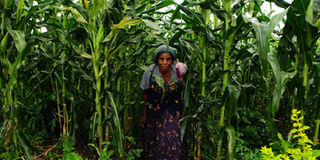Good agronomy practices improve Kakuka’s maize yields

Jane Kakuka emerges from her maize garden in Katerera, Rubirizi District. Photo by Rachel Mabala
What you need to know:
- Jane Kakuka has adopted better maize growing practices to achieve good yields, writes FRED MUZAALE.
A casual look at Jane Kakuka’s maize garden, in Katerera village, Rubirizi District, tells much about how she strictly follows the proper agronomy practices to the letter.
Compared to other farmers’ maize gardens in the same area, Kakuka’s garden of about four acres is quite different.
The plants are healthy, tall and green, each with big maize corns.
However, other farmers’ maize crops neighbouring Kakuka’s garden are stunted, yellowish, with small maize corns.
“Some farmers in this village think I bewitched their crops, but they forget that the trick only lies in observing good agronomy practices. I follow the advice I get from extension workers,” a beaming 65-year-old Kakuka says.
However, the commercial maize farmer says four years ago, her crops looked the same as those of other farmers.
“I used to inter-crop my maize with beans, cassava and other crops, which resulted in poor yields,” she recalls.
This, she explains, was before she joined, Katerera Area Cooperative Enterprise Ltd, a farmers’ organisation that was formed with an aim of improving farmers’ livelihood through production, marketing and value addition.
The enterprise, according to Dennis Asingwire the manager, now has a membership of 6,211 farmers.
Kakuka says when she joined the enterprise four years ago, its extension workers, trained her in good agronomy practices such as proper spacing, early planting and weeding plus fertiliser application and disease and pest control.
Subsequent to the training, Kakuka put the knowledge she received into practice.
She says she now grows Longe 5 maize variety whose seeds she buys at between Shs3,200 and Shs3,500 per kilogramme.
This variety, she says is high-yielding compared to the hybrid maize seeds which cost Shs8, 000 per kilogramme.
“Because of the training I received from the extension workers, I plant my maize at spacing of 75 centimetres from one line to another and 30 centimetres from plant to plant,” she says adding, “however, in each hole I apply DAP fertiliser, which I cover with little soil, then plant three seeds. But after germinating I remove one and remain with two, which ensures that they grow when they are healthy,”
Because of all this she says she harvests two tonnes of maize grain (2,000 kilogrammes) from an acre compared to only two or three bags, which she used to get previously.
Asingwire says they are able to provide extension services and other services to members because of the support they received from aBi Trust in 2012.
“aBi trust has helped us train farmers, pay salaries of our staff and also put in place demonstration gardens, all which have led to increased production,” Asingwire notes.
He adds that the enterprise also provides crop finance to farmers which they pay back after harvesting.
After harvesting the maize, Kakuka threshes it and takes it to the enterprises’ store.
She stores the maize grains when prices are low and is given a receipt which she keeps.
However, after two or three months (after harvesting) the prices go up and this is when her maize is sold.
For instance, she says, last season, she sold her maize grain at Shs1,600 per kilo, which was a good price.
Achievements
Among the achievements, Kakuka says is that she has been able to save with their village savings and loan association (VSLA).
Also, she has been able to pay school fees for her children and grandchildren using proceeds from selling maize.
Besides, she has also saved some money, which she has used to buy another piece of land.
Challenges
Her biggest challenge is the fall armyworm that devastated her garden and reduced her yields last season. She says she invested a substantial amount of money in buying pesticides to fight them.
She also says that because of her advancing age, she cannot effectively attend to her garden so she has to employ four workers who help her in planting, weeding and harvesting.
She also reveals that the changes in climate last season affected her yields.
Advice:
The maize plant produces high dry matter yields and therefore has a high requirement for nutrients especially nitrogen (N), phosphorus (P) and potassium (K). It is not usually necessary to apply fertiliser to supply all the crops nutrient requirements.




